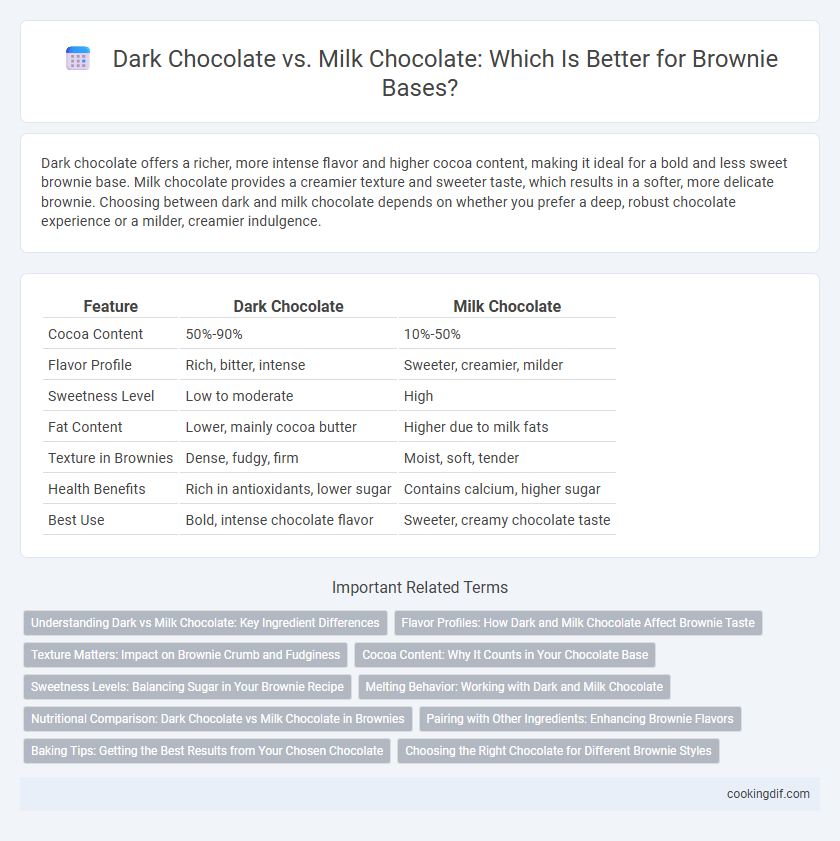Dark chocolate offers a richer, more intense flavor and higher cocoa content, making it ideal for a bold and less sweet brownie base. Milk chocolate provides a creamier texture and sweeter taste, which results in a softer, more delicate brownie. Choosing between dark and milk chocolate depends on whether you prefer a deep, robust chocolate experience or a milder, creamier indulgence.
Table of Comparison
| Feature | Dark Chocolate | Milk Chocolate |
|---|---|---|
| Cocoa Content | 50%-90% | 10%-50% |
| Flavor Profile | Rich, bitter, intense | Sweeter, creamier, milder |
| Sweetness Level | Low to moderate | High |
| Fat Content | Lower, mainly cocoa butter | Higher due to milk fats |
| Texture in Brownies | Dense, fudgy, firm | Moist, soft, tender |
| Health Benefits | Rich in antioxidants, lower sugar | Contains calcium, higher sugar |
| Best Use | Bold, intense chocolate flavor | Sweeter, creamy chocolate taste |
Understanding Dark vs Milk Chocolate: Key Ingredient Differences
Dark chocolate contains a higher percentage of cocoa solids, typically between 50% and 90%, which gives brownies a rich, intense flavor and denser texture. Milk chocolate includes more milk solids and sugar, resulting in a sweeter, creamier taste and softer texture in the brownie base. Understanding these key ingredient differences helps bakers choose the ideal chocolate type to achieve the desired balance of bitterness and sweetness in brownies.
Flavor Profiles: How Dark and Milk Chocolate Affect Brownie Taste
Dark chocolate imparts a rich, intense cocoa flavor with slight bitterness that deepens the brownie's complexity and highlights its fudgy texture. Milk chocolate offers a sweeter, creamier taste with subtle caramel and vanilla notes, resulting in a smoother, more mellow brownie flavor. Choosing dark chocolate enhances the boldness and cocoa intensity, while milk chocolate creates a sweeter, milder brownie experience.
Texture Matters: Impact on Brownie Crumb and Fudginess
Dark chocolate enhances brownie texture by creating a denser, fudgier crumb due to its higher cocoa content and lower sugar levels. Milk chocolate, with its creamier fat content and added milk solids, produces a lighter, softer crumb that is less fudgy but more tender. Choosing dark chocolate intensifies the rich, chewy consistency prized in classic brownies, while milk chocolate yields a smoother, more cake-like crumb.
Cocoa Content: Why It Counts in Your Chocolate Base
Dark chocolate typically contains 50-90% cocoa solids, providing a rich, intense flavor and higher antioxidant levels, which enhance the brownie's depth and health benefits. Milk chocolate generally has 10-50% cocoa content, resulting in a creamier texture and sweeter taste that softens the brownie's overall flavor profile. Choosing a higher cocoa content in the chocolate base significantly impacts the brownie's bitterness, complexity, and nutritional profile.
Sweetness Levels: Balancing Sugar in Your Brownie Recipe
Dark chocolate contains less sugar than milk chocolate, making it a better choice for brownies when controlling sweetness levels is important. Using dark chocolate as the base results in a richer, less sweet dessert, allowing bakers to adjust additional sugar in the recipe precisely. Milk chocolate's higher sugar content can overpower subtle flavors and may require reducing added sugar to maintain balance in the brownie's sweetness.
Melting Behavior: Working with Dark and Milk Chocolate
Dark chocolate has a higher cocoa content and less sugar, resulting in a higher melting point and a thicker, more stable melt ideal for creating dense brownie bases. Milk chocolate contains more milk solids and sugar, lowering its melting temperature, which produces a creamier, smoother texture but can make it less stable during baking. Understanding these melting behaviors helps bakers achieve the desired texture and firmness in brownies by selecting the appropriate chocolate type for the base.
Nutritional Comparison: Dark Chocolate vs Milk Chocolate in Brownies
Dark chocolate used in brownies typically contains higher cocoa content, providing increased antioxidants, fiber, and minerals like iron and magnesium compared to milk chocolate. Milk chocolate has a higher sugar and fat content due to added milk solids, which can increase calorie count and reduce the overall nutritional density of the brownie. Choosing dark chocolate for brownie bases enhances nutritional benefits by offering lower sugar levels and richer flavonoid content.
Pairing with Other Ingredients: Enhancing Brownie Flavors
Dark chocolate's intense, slightly bitter flavor pairs exceptionally well with robust ingredients like espresso, nuts, and dried fruits, enhancing the depth and complexity of brownies. Milk chocolate, with its creamy and sweeter profile, complements ingredients such as caramel, vanilla, and fresh berries, creating a rich and balanced taste experience. Selecting the chocolate base based on desired flavor pairings elevates the overall brownie, making each bite more harmonious and flavorful.
Baking Tips: Getting the Best Results from Your Chosen Chocolate
Dark chocolate offers a richer, more intense cocoa flavor and higher cocoa content, making it ideal for fudgy, dense brownies with a deep chocolate taste. Milk chocolate, containing more sugar and milk solids, yields a sweeter, creamier texture that can soften the overall brownie crumb. For optimal baking results, use high-quality dark chocolate with at least 70% cocoa for complex flavor depth, or choose milk chocolate with lower cocoa percentages to enhance sweetness and moisture in the final product.
Choosing the Right Chocolate for Different Brownie Styles
Dark chocolate enriches brownies with intense cocoa flavor and a fudgy, dense texture, ideal for classic rich or gourmet brownie styles. Milk chocolate offers a sweeter, creamier profile that produces lighter, softer brownies, perfect for those favoring a milder chocolate taste or dessert bars with added ingredients like nuts or caramel. Selecting between dark and milk chocolate significantly influences the brownie's sweetness, texture, and overall flavor complexity tailored to varied preferences.
Dark chocolate vs Milk chocolate for chocolate base Infographic

 cookingdif.com
cookingdif.com